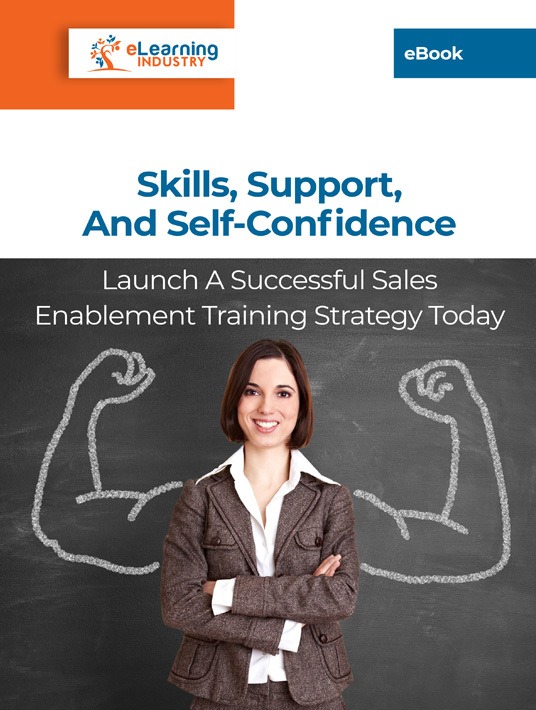8 Reasons To Launch A Sales Enablement Plan
Every training initiative requires a strong business case. You need to prove that the new strategy will deliver maximum ROI to achieve internal buy-in. And I’m not just referring to the accounting department. Employees must be aware of the real-world benefits to truly engage with the online training content and get the most from the L&D experience. The success of your strategy hinges on their participation and real-world application. So, what can sales enablement training bring to your organization? Are there any unexpected perks you can use to pitch the program to higher-ups by incorporating them into your internal marketing strategy?

1. Boost Customer Loyalty
Customers usually don’t want to do business with companies that treat them like numbers. They expect employees to interact with them to identify everyday concerns and find the right product for them. Sales enablement training preps your team for meaningful customer engagement, thereby, boosting consumer loyalty and overall satisfaction scores. They’re more likely to bring in repeat business and referrals if you help them make well-informed buying decisions.
2. Retain Top Performers
Sales enablement solutions also ensure that your top talent stays put. They have all the support they need to pitch products with confidence and give customers the best service possible. They’re more confident on the job because your company has invested in their ongoing development, instead of focusing solely on sales goals and pushing them out of their professional comfort zone. As a result, you retain top performers and don’t have to pay for their replacements (i.e., hiring and training costs).
3. Mitigate Compliance Risks
Compliance violations can take a bite out of your budget both in terms of regulatory fines and a tarnished brand reputation. Sales enablement training helps mitigate risks by keeping your employees in-the-know. They have access to updated support resources regarding company policy, rules, and protocols. For example, how to collect customer data without violating any privacy acts.
4. Reduce Return Rates
Customers are less likely to return products if they have received stellar service in the first place, if a sales employee helped them choose the right product based on their pain points, price point, and expectations. If a product is faulty, they’ll probably ask for an exchange instead of a full-fledged refund. This lessens the impact on your bottom line. Furthermore, your customer service staff received personalized sales enablement resources for their department. This means that they know how to interact with the consumer and empathize with their situation to boost loyalty.
5. Improve Online Training ROI
Sales enablement solutions may require an investment. However, if you implement them correctly, you can improve ROI and maximize resource allocation. This is due to the fact that employees get more benefit from the experience and are able to apply what they learn in the workplace. Simulations, branching scenarios, and games help them move from theoretical knowledge to practical use. This stretches your budget and widens your profit margins.
6. Identify Qualified Leads
Everyone who comes into contact with your brand should feel like they matter. Even those who are just casually researching products or services and don’t plan on an immediate purchase. That said, your employees should be able to distinguish a qualified lead from a consumer who’s simply doing their homework. A sales enablement strategy gives them tools to qualify prospects and customize their approach based on buyer intent. For instance, a consumer who already knows a great deal about the product may not need as much background info. They’re already past the research phase and are ready to buy. As such, the employee must adjust their plan of action and focus on overlooked selling points and add-ons.
7. Build Your Brand Image
Most well-known brands have one thing in common: they’re customer-focused. Their name has earned a reputation for building trust and credibility in their industry. Sales enablement solutions can bring the same profitable perk to your organization. Customers will know that your employees are knowledgeable and respectful. That they will work with them to make the right purchase and that they value CX over making a quick sale. However, you should bear in mind that every stage of the buying journey is equally important, not just vetting prospects and ringing them up. For example, employees should follow up with customers after the purchase to ensure their satisfaction.
8. Improve Conversions
Lastly, customers are more likely to buy your products or services if the employee knows their stuff. They must also be approachable and represent your brand with dignity and professionalism. Sales enablement training improves conversions because your entire L&D strategy is based on customer service. You don’t just focus on the end result, but on how consumers are treated during the transaction. In other words, everyone who interacts with your company gets the individualized support they’ve come to expect. Even casual visitors are won over by your amazing service and decide to purchase the product. That’s the sign of a truly effective sales enablement strategy that’s customer-centered and results-driven.
Sales enablement solutions can benefit your bottom line if they’re custom-tailored to your team’s needs and focus on Customer Experience. Your sales staffers should have all the support tools they require to bridge skill gaps autonomously and qualify potential leads. It’s a holistic approach that covers every phase of the customer cycle. Thus, the first step is to map out the journey and ensure that your current sales operations training has all the essentials. Then develop new online training content to fill the holes and address areas for improvement.
If you want to learn more about implementing successful sales operations training, download our eBook Skills, Support, And Self-Confidence: Launch A Successful Sales Enablement Training Strategy Today. You will find all the information you need to train your sales team so that they gain the expertise and confidence they need to skyrocket their performance and offer unparalleled Customer Experience.

